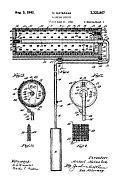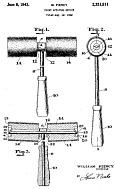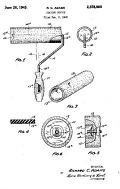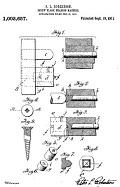Canadian Inventions
You didn't know were Canadian
Egg Carton
 An egg farmer was arguing with a
hotel owner about broken eggs. The
hotelier had ordered eggs from the farmer.
An egg farmer was arguing with a
hotel owner about broken eggs. The
hotelier had ordered eggs from the farmer.
After the eggs were delivered, some of them were discovered to have cracks.
According to the farmer, the eggs were perfectly fine when he delivered them, but the hotel owner was adamant his staff didn't break them.
As the story goes, this wasn't the first time this argument had taken place. One was always blaming the other for breaking the eggs.
To resolve the problem they turned to their friend, Joseph Coyle. Coyle was the editor for the local newspaper in Smithers, British Columbia. He was considered a fair and intelligent man.
 Coyle listened to his friends
carefully and suggested that
the problem was the egg
baskets. He told them he
would try to create
something better for transporting
and storing eggs.
Coyle listened to his friends
carefully and suggested that
the problem was the egg
baskets. He told them he
would try to create
something better for transporting
and storing eggs.
Coyle's willingness to create a product was not entirely surprising since he was also an inventor. He previously invented a pedal boat and a machine for brushing wool.
So in 1911, Coyle created a dimpled egg carton made from folded newspaper. He also designed machinery to manufacture the cartons.
Licensing rights were granted to manufacturers in Chicago, Pittsburgh and New York, all of whom became very wealthy selling egg cartons throughout the world.
Sources: bcnorth.ca; creativecommons.org
Paint Roller
 In 1939, Norman Breakey met with
Tom Hamilton, a salesman with A. B.
Caya Fabrics, an upholstery and
drapery fabric supplier in Kitchener,
Ontario.
In 1939, Norman Breakey met with
Tom Hamilton, a salesman with A. B.
Caya Fabrics, an upholstery and
drapery fabric supplier in Kitchener,
Ontario.
"He was looking for a fabric with a stiff bristly nap that could be used to cover a roll of cardboard," said Hamilton, referring to Breakey's idea for a paint roller.
Hamilton explained that the invention was a fabric-covered cardboard cylinder that slide onto a handle shaped like a number "7".
The cylinder rolled in a tray of paint and the paint was then rolled onto a surface from the cylinder.
Breakey used a fabric covering made of green mohair velour glued to the cylinder
He sold his paint rollers to hardware stores in Toronto with full confidence that his invention would revolutionize painting.
But Breaky was a one-man operation. He didn't have the resources to manufacture or market his popular paint roller on a large scale. He didn't have the investors he needed. He didn't file for any patents.
 Soon thereafter, other inventors began
inventing their own versions of Breakey's
paint roller.
Soon thereafter, other inventors began
inventing their own versions of Breakey's
paint roller.
In August 1941, Michael Matsakas of Chicago, was granted a patent for a fountain paint roller that dispersed paint from inside a cylinder.
 In June, 1943, William
Percy of Philadelphia patented a
split-headed paint roller.
In June, 1943, William
Percy of Philadelphia patented a
split-headed paint roller.
In Dec, 1946, Richard C, Adams of Cleveland, Ohio received a patent for his roller paint applicator, which he assigned to his employer, the Sherwin-Williams paint company.

It could be argued that some of these patents should never have been granted.
You cannot patent a product if it was invented by someone else even though they never filed for a patent.
As a result, there was nothing stopping anyone from making and selling paint rollers.
Breakey was right about one thing - his invention did revolutionize painting.
The paint roller is one of those great Canadian inventions that few people know was invented in Canada.
Sources: torontoist.com; uwaterloo.ca; creativecommons.org
Robertson Screw
 Peter Robertson, a Canadian
industrialist, invented the square-socket
screw, also known as a
Robertson screw.
Peter Robertson, a Canadian
industrialist, invented the square-socket
screw, also known as a
Robertson screw.
The idea of a square screw socket wasn't new but no one could make one.
Robertson invented a machine and a cold forming process to make the screws, which he patented on September 19, 1911.
 Robertson also invented a
combination slot and square screw,
which he patented on May 23, 1933.
Robertson also invented a
combination slot and square screw,
which he patented on May 23, 1933.
A common problem with slot screws was that a straight-blade screwdriver would easily slip out of the slot.
The Robertson screwdriver prevented slipping and you could use one hand to tighten the screws.
The invention was so popular that Henry Ford pursued an exclusive license to make and sell the product in the United States.
Ford used the screws to make his Model T Fords because it reduced the time it took to make his cars. About 700 Robertson screws were used to assemble the body, which Ford estimated saved him about 2 hours of labor compared to using slot screws.
 But Ford and Robertson
couldn't agree on a licensing arrangement,
and Ford eventually made a deal for
another socket screw invented by
Henry Phillips.
But Ford and Robertson
couldn't agree on a licensing arrangement,
and Ford eventually made a deal for
another socket screw invented by
Henry Phillips.
Due to Ford's connections and influence, Philips became the screw of choice for most American manufacturers.
Although Robertson was not able to finalize a lucrative licensing deal with Ford, his invention did become the standard for boat manufacturers, which made Robertson a wealthy man.
Sources: robertsonscrew.com; creativecommons.org
Canola
 Rapeseed oil is a vegetable oil that was used for
centuries as a high-quality
lubricant. It's bitter taste and toxic
levels of erucic acid make it unfit for consumption.
Rapeseed oil is a vegetable oil that was used for
centuries as a high-quality
lubricant. It's bitter taste and toxic
levels of erucic acid make it unfit for consumption.
In 1972, Canadian scientists, Keith Downey and Baldur R. Stefansson, successfully crossbred rapeseed removing toxins from it's oil and improving it's taste.
Their new vegetable oil contained about 60% oleic acid, 20% linoleic acid and 10% linolenic acid.
It's low levels of saturated fatty acids and ideal ratio of omega-6 to omega-3 acids, and 0 trans fats, make it among the heathiest oils for consumption.
This new plant was called "canola" and was classified to the Brassicaceae (Cruciferae) family of plants, which includes turnips, cabbage and mustard.
The name "canola" is derived from the term "Canadian Oil Low Acid".
An international definition for "canola" also applies to any oilseed that has less than 2% erucic acid and under 30 umoles of glucosinolates (a type of fat).
Canola oil is used in margarine, salad dressings, shortening and cooking oils. The meal byproduct from oil extraction is used as a high-protein feed for livestock.
Canola is among the top 3 best selling vegetable oils in the world and it's the reason why Canada produces more than 13 million tonnes of canola annually.
Sources: umanitoba.ca: creativecommons.org




